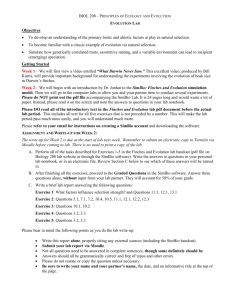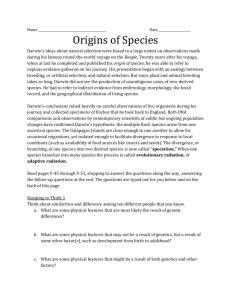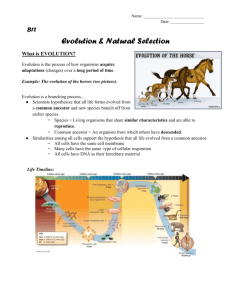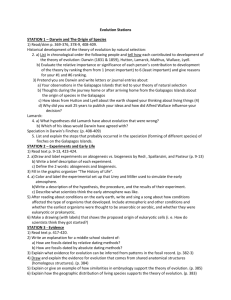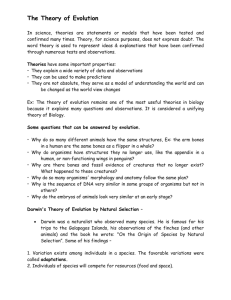ap biology summer work
advertisement
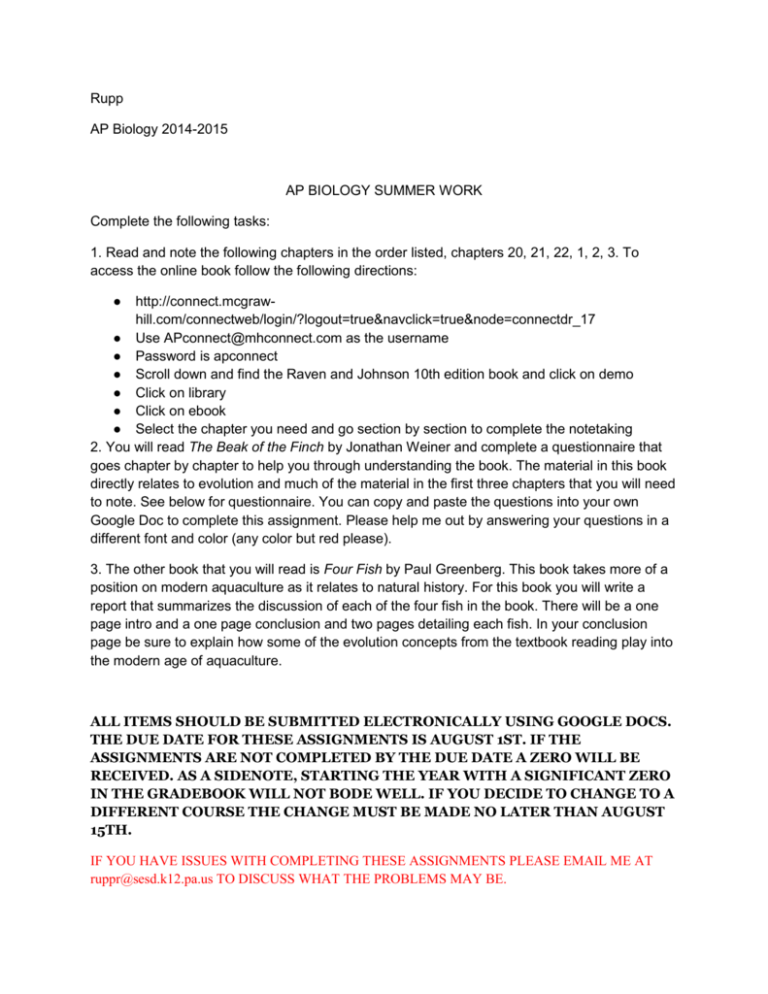
Rupp AP Biology 2014-2015 AP BIOLOGY SUMMER WORK Complete the following tasks: 1. Read and note the following chapters in the order listed, chapters 20, 21, 22, 1, 2, 3. To access the online book follow the following directions: ● http://connect.mcgrawhill.com/connectweb/login/?logout=true&navclick=true&node=connectdr_17 ● Use APconnect@mhconnect.com as the username ● Password is apconnect ● Scroll down and find the Raven and Johnson 10th edition book and click on demo ● Click on library ● Click on ebook ● Select the chapter you need and go section by section to complete the notetaking 2. You will read The Beak of the Finch by Jonathan Weiner and complete a questionnaire that goes chapter by chapter to help you through understanding the book. The material in this book directly relates to evolution and much of the material in the first three chapters that you will need to note. See below for questionnaire. You can copy and paste the questions into your own Google Doc to complete this assignment. Please help me out by answering your questions in a different font and color (any color but red please). 3. The other book that you will read is Four Fish by Paul Greenberg. This book takes more of a position on modern aquaculture as it relates to natural history. For this book you will write a report that summarizes the discussion of each of the four fish in the book. There will be a one page intro and a one page conclusion and two pages detailing each fish. In your conclusion page be sure to explain how some of the evolution concepts from the textbook reading play into the modern age of aquaculture. ALL ITEMS SHOULD BE SUBMITTED ELECTRONICALLY USING GOOGLE DOCS. THE DUE DATE FOR THESE ASSIGNMENTS IS AUGUST 1ST. IF THE ASSIGNMENTS ARE NOT COMPLETED BY THE DUE DATE A ZERO WILL BE RECEIVED. AS A SIDENOTE, STARTING THE YEAR WITH A SIGNIFICANT ZERO IN THE GRADEBOOK WILL NOT BODE WELL. IF YOU DECIDE TO CHANGE TO A DIFFERENT COURSE THE CHANGE MUST BE MADE NO LATER THAN AUGUST 15TH. IF YOU HAVE ISSUES WITH COMPLETING THESE ASSIGNMENTS PLEASE EMAIL ME AT ruppr@sesd.k12.pa.us TO DISCUSS WHAT THE PROBLEMS MAY BE. Chapter 1 1. Describe the measurements the Grants take on each finch. 2. Describe Darwin’s explanation of natural selection. a. Did Darwin ever observe natural selection in action? b. Why did Darwin believe we could never "watch" natural selection in action? 3. Explain why the finches on Daphne Island are such an ideal population to study. Chapter 2 1. Describe why the Galápagos finches are referred to as nature’s “most famous toolkit.” 2. Describe the hints we have that Linné (Linneaus) wondered about evolution. 3. Explain how Charles Lyell's Principles of Geology influenced Darwin. 4. Explain how John Gould's discovery that there were 14 (13) species of finches on the Galápagos help spark Darwin's revolutionary ideas. 5. Propose a reason why Darwin begins The Origin with a detailed description of pigeon breeding. Chapter 3 1. Justify Darwin's explanation for the lack of transitional forms between species. 2. Compare the large, medium, and small ground finches with respect to their beaks. 3. Compare the variation in populations of Darwin's finches with variation among populations of other birds, like sparrows. 4. Explain why the study of variation is so important to evolutionary biology. Chapter 4 1. Propose reasons why 19th and early 20th century biologists failed to recognize the importance of variation in beak size among Darwin's finches in the Galápagos. 2. Explain how David Lack's observations of the distribution of finch species in the Galápagos lead him to conclude that natural selection had indeed been at work. 3. Describe how the finches' feeding behavior changed during the dry season. 4. Describe the three requirements of Darwin's theory of natural selection that are found in populations of Darwin's finches. Chapter 5 1. Describe how the drought of 1977 affected the feeding behavior of finches on Daphne Island. 2. Justify why the Grants, Peter Boag and Laurene Ratcliffe didn’t immediately recognize the episode of natural selection at work during the drought. 3. Explain how natural selection changed the morphology of the finch populations on Daphne Island from 1977 to 1978. Chapter 6 1. Compare the "costs and benefits" of black plumage among male Darwin's finches. 2. Provide a “cost-benefit analysis” of John Endler’s guppy of South America with respect to their colorful spots. 3. Describe Endler's "natural" selection experiments with guppies. Chapter 7 1. Describe the selection response in the aftermath of El Niño on Darwin's finches. 2. Explain how biologists have reconciled the apparent paradox of rapid evolution in the short term with much slower evolutionary rates measured in the fossil record. 3. Explain how the results of natural selection in Darwin's finches and British Columbian sparrows may change the definition of species. Chapter 8 1. Compare the success of finch hybrids before the El Niño of 1983 with those hatched afterwards. Chapter 9 1. Explain why Peter Grant describes evolution as "change in variation." 2. Explain why there was so much debate over whether natural selection could give rise to new species. Chapter 10 1. Identify and describe Darwin's "incipient species." 2. Describe and explain the concept of adaptive radiation. 3. Explain how Darwin imagined the "principle of divergence" could lead to new species. 4. Describe and explain the concepts of competitive exclusion and character displacement. 5. Justify how Dolph Schluter's findings support the concept of character displacement. 6. Describe and explain what is meant by an adaptive landscape. Chapter 11 1. Explain what is meant by the "invisible coasts" described in this chapter. 2. Identify and describe ways species are more "fluid" than even 20th century biologists might have believed. 3. Discuss to what extent Darwin's description of species as "convenient constructions" is accurate. 4. Discuss whether or not species are real and exist. Chapter 12 1. Discuss how Benkman's and Lindholm's research on crossbills supports the notion that gradual evolution can lead to the appearance of complex adaptations. 2. Explain how the stickleback fishes in British Columbian lakes studied by Dolph Schluter and John Donald McPhail are similar to Darwin's finches. Chapter 13 1. Describe how the finch populations on Daphne Major have responded to the changing adaptive landscape. 2. Explain how hybridization might aid in a species' shift to a new adaptive peak in the landscape. Chapter 14 1. Describe the process of inductive reasoning. 2. Explain the role inductive reasoning plays in science. Chapter 15 1. Describe what Peter Boag hopes to find by analyzing finch DNA. Chapter 16 1. Describe sympatric speciation. 2. Explain how the observations of haw flies and apple maggot flies support the notion of sympatric speciation. Chapter 17 1. Describe introgressive hybridization. 2. Discuss what role introgressive hybridization might it play in evolution. Chapter 18 1. Joshua Ledergerg said, "Our only real competition for domination of the planet remains the viruses." In what respect could you make a similar argument about insects? Chapter 19 1. Predict and justify the effects global warming might have on the ground finches of the Galápagos. 2. Weiner suggests that we live in extraordinary times, evolutionarily speaking. Do you agree? Why or why not? Chapter 20 1. Discuss way(s) cultural evolution is similar and different to "regular" evolution. 2. Discuss ways cultural evolution has affected the success of our species. Epilogue 1. "The thinking niche is taken...” Do you agree? Explain your answer.


